Business Advertising






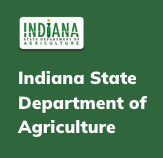
The Indiana State Department of Agriculture (ISDA) submitted an inventory of lost farmland report to the Legislative Council. In 2023, the Indiana General Assembly passed House Enrolled Act 1557, which tasked ISDA to complete an inventory of lost farmland in Indiana from 2010-2022.
ISDA determined through the inventory of lost farmland that there has been an overall reduction of farmland acres of approximately 1.5-2% from 2010-2022. This represents a loss of approximately 350,000 acres. The results show that agricultural land was most likely to be lost in areas around the edges of cities and suburban areas. The primary cause of reduction in farmland was due to residential use.
“Agriculture is, and always has been, the lifeblood of the Hoosier state,” said Lt. Gov. Suzanne Crouch, Secretary of Agriculture and Rural Development. “Data is critical for all levels of government when making decisions that may affect our rural communities and food security.”
ISDA used two sources of data – (1) parcel data from the Indiana Department of Local Government Finance(DLGF) and (2) the United States Department of Agriculture (USDA) National Agricultural Statistics Service (NASS) Crop Data Layer (CDL). Both datasets have different qualities that make them desirable for attempting to discern both the quantity of land use change and the causes of land use change.
“The inventory of lost farmland was an opportunity for ISDA and legislators to gain access to reliable data, where up until now, we could only make assumptions,” said Don Lamb, director of the Indiana State Department of Agriculture. “This information is important to have for policy development as we work to balance economic growth, food security and the preservation of agricultural land, because we know when agriculture is strong, Indiana is too.”
Despite the loss in acreage, yield data from USDA NASS shows that Indiana’s production of its cash crops has increased. In 2012, Indiana produced over 597 million bushels of corn for grain, and in 2022 yielded over 1 billion bushels. Indiana produced nearly 219 million bushels of soybeans in 2012 and saw that number increase to over 326 million in 2022.
ISDA outlined several recommendations within the report to the Legislative Council, including that legislation be passed directing ISDA to update the inventory of lost farmland every five years, starting in 2029 for a report to be published in 2030.
To view the full 2010 to 2022 report or narrative, click here or visit isda.in.gov.

This informal report by the Division of Entomology & Plant Pathology is a commentary on insects, diseases, and curiosities division staff encounter on a week-to-week basis. Comments and questions about this report are welcome and can be sent to your respective Inspector.
Our Website
Inspector Territories
Diane Turner (Nursery Inspector & Compliance Officer) –
Tomato spotted wilt virus (TSWV) is a well-known Tospovirus that is associated with a thrips vector. TSWV is believed to have the widest host range of any plant virus, infecting more than 900 plant species. The photographs below were taken at a recent inspection, showing a Hosta ‘Barbara Ann’ container displaying viral leaf symptoms including necrosis, chlorotic rings, and mottled ring patterns. This sample was sent to the Purdue Plant and Pest Diagnostic Lab and was confirmed to be infected with TSWV.
TSWV is extremely difficult to manage because of the wide and overlapping host ranges for this virus and its vectors. Once a plant is infected, no chemical treatments can cure it. Thus, avoidance is a common management strategy, for instance, the exclusion of thrips from production areas to reduce infection by TSWV.
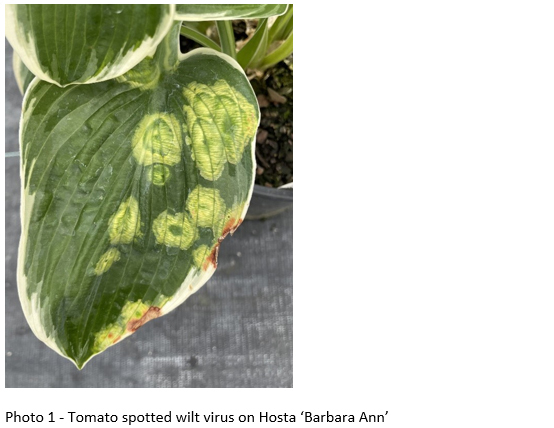
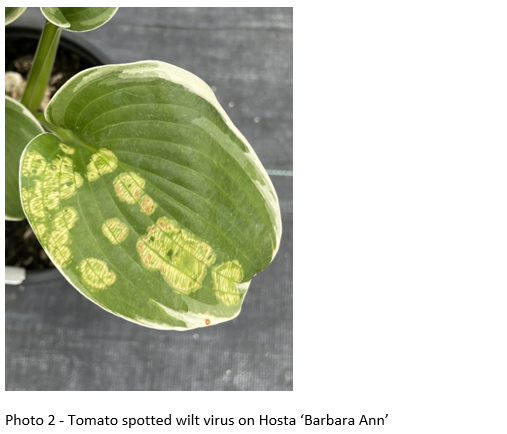
Jared Spokowsky (Nursery Inspetor & Compliance Officer) -
Nothing too extraordinary was found last week. I did see a pretty extensive amount of herbicide damage, but I don’t think it was drift. I have a feeling this was self-inflicted by the nursery.
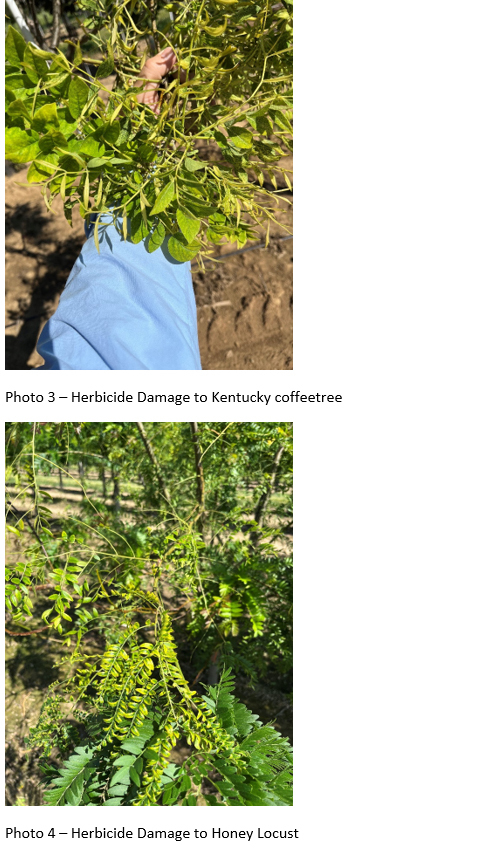
I got distracted while playing kickball with my kids which promptly elicited the response “Dad’s taking pictures of bugs again.” I spotted a five-banded thynnid wasp (Myzinum quinquecinctum) which are parasitoids on scarab beetles. For more information on this species please follow this link.
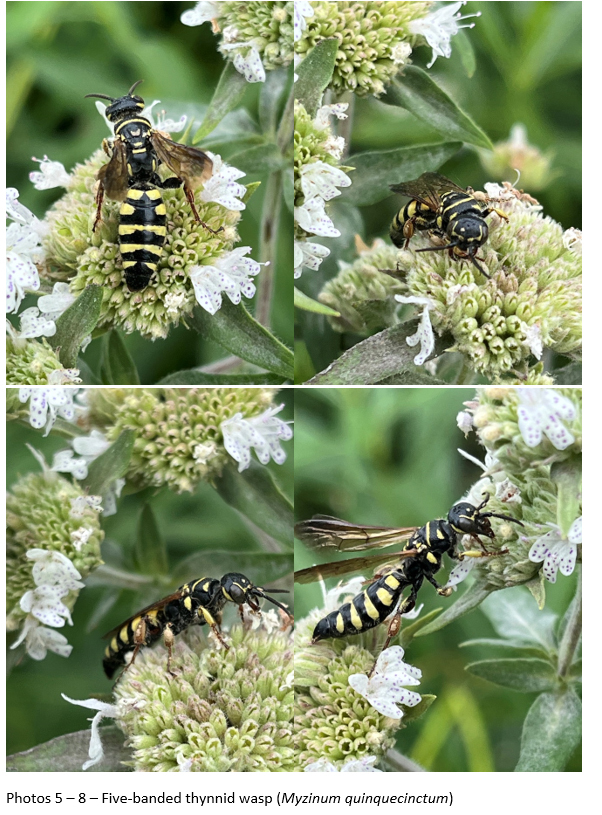
Finally, an update on the yellow-legged hornet situation in GA.
- Total traps deployed (August 2023 - July 2024): 1,029
- Hornets found (July 4, 2024 - July 18, 2024): 53 workers / 22 queens
- January 2024 - July 2024: 4 embryo nests; 4 primary nests; 3 secondary nests
Will Drews (Nursery Inspector & Compliance Officer) -
A couple of nurseries in my area have been dealing with a tough nursery pest issue: foliar nematodes. Foliar nematodes are nematodes (i.e., microscopic round worms) mostly in the genus Aphelenchoides. Most nematode species are found in the soil and are an important part of soil ecosystems. However, some species are parasitic and impact plants, animals, and even humans. Most plant parasitic nematodes affect the roots of plants, but some species in the Aphelenchoidesgenus feed on the foliage of a number of plant species, including ornamental perennials, trees, shrubs, fruits, and vegetable crops.
The clearest sign of foliar nematode damage is the angular leaf spots that develop in between leaf veins. Foliar nematodes will both feed on the outside as well as inside of host leaves. Their stylets (aka piercing mouthparts) are used to feed on the plant tissue and cause the interveinal leaf spots. The angular leaf spots will often start lightly discolored, and then after more feeding, will turn browner and eventually cause dead patches. At any point in the mid to late summer, a geometric patchwork patterning can be observed on leaves as the foliar nematodes move from one interveinal section to another. Movement to other sections of an individual plant as well as other surrounding plants is facilitated by water, normally overhead irrigation or rain.
Control of foliar nematodes is very difficult because of their size and their ability to feed within plant leaf tissue. There are no chemical control options for homeowners and very few for only a couple of crop production scenarios. Some dormant hot water treatments have been used to successfully control foliar nematodes; however, incorrect timing and temperature can lead to either plant mortality or ineffective nematode control. Most extension sources recommend proper sanitation, watering practices (e.g. drip instead of overhead irrigation), and prevention as the best way to avoid foliar nematodes. If foliar nematodes are found on plant stock, the infected material should be disposed of as soon as it is noticed by removing and bagging it.
Here are some of the pictures I have taken recently of foliar nematodes and their damage:
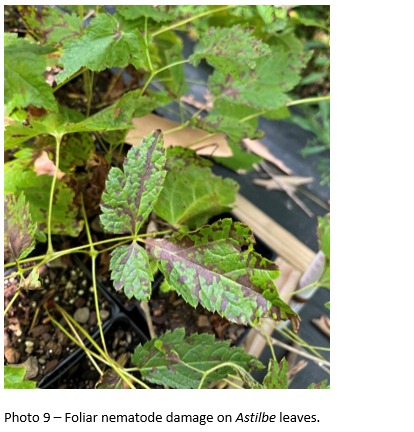
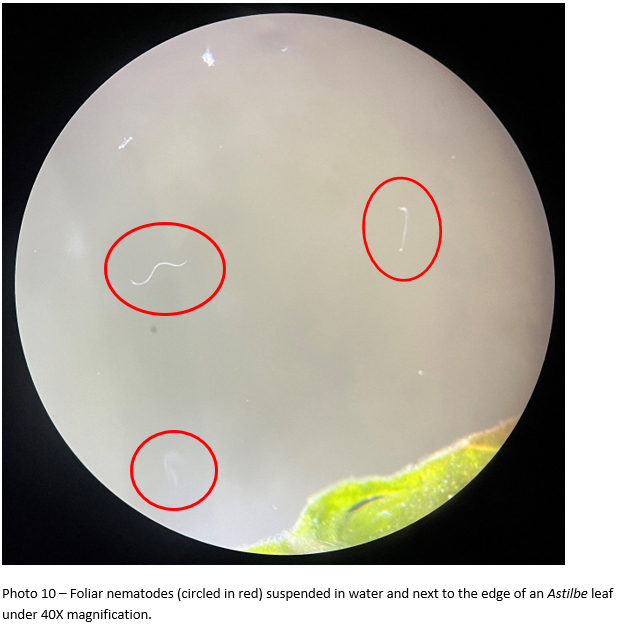
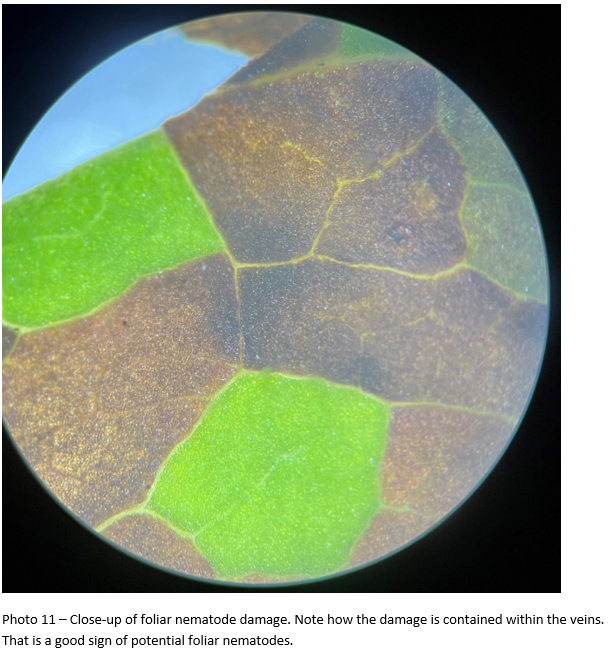
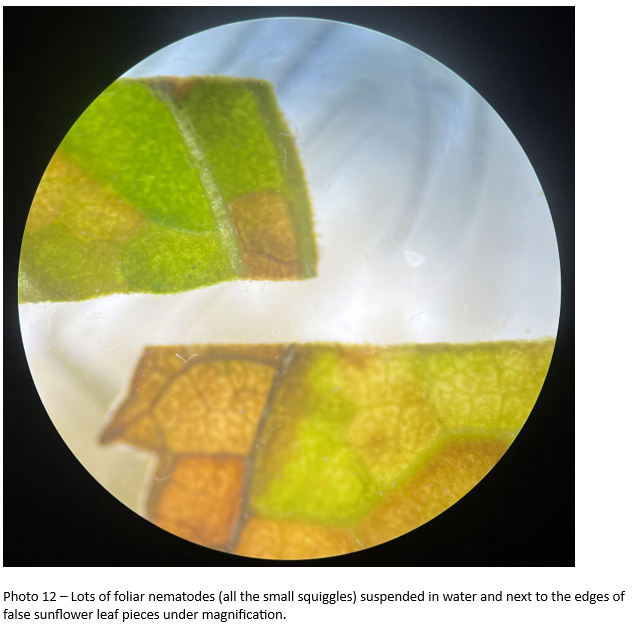
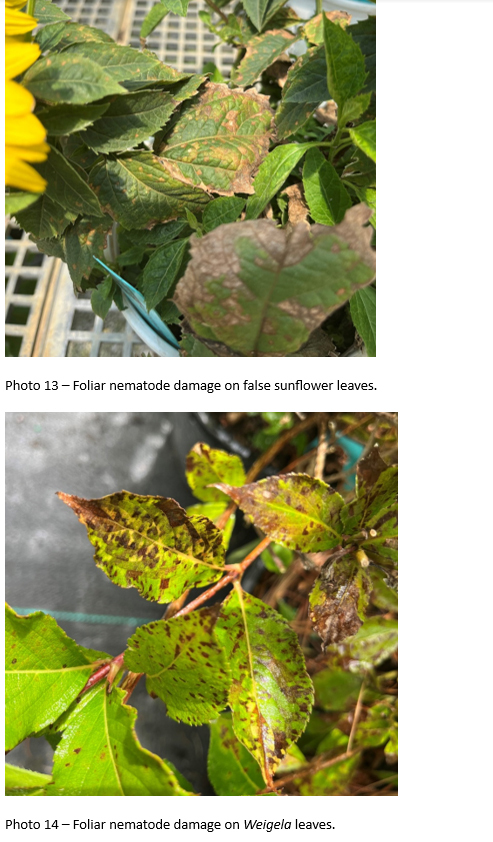

Angela Rust (Nursery Inspector & Compliance Officer) -
This week I have included a photo of lab confirmed Pseudocercospora leaf spot on common purple lilac. This leaf spot is caused by a fungus and is common in the landscape. Please see this link on common lilac diseases. Also Included are two photos showing heavy snail feeding damage on rhubarb.
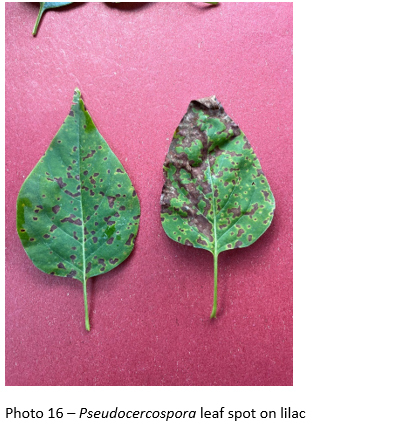

Eric Biddinger (Nursery Inspector & Compliance Officer) -
A few finds from last week’s inspections:
I have been seeing a marked increase in spider mite damage on a wide variety of hosts, both in the field and in poly houses. Two-spotted and maple mites are the more common species I have seen.
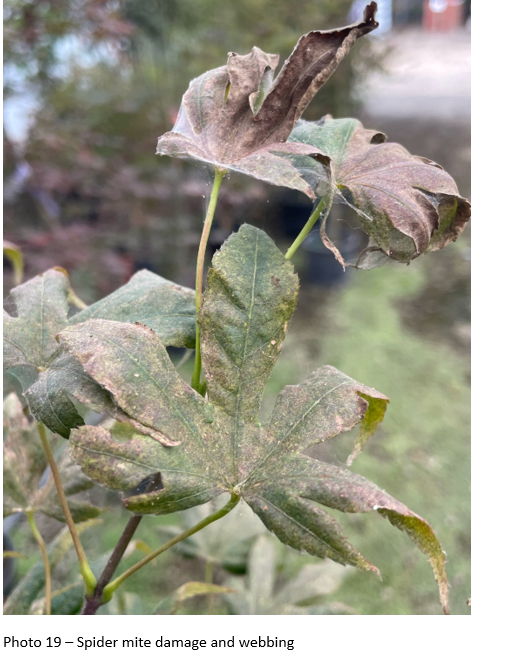
One rhododendron at a nursery had notched leaves. This is an indicator for black vine weevil. As BVW is a regulated pest, this plant needed to be scrutinized closely.
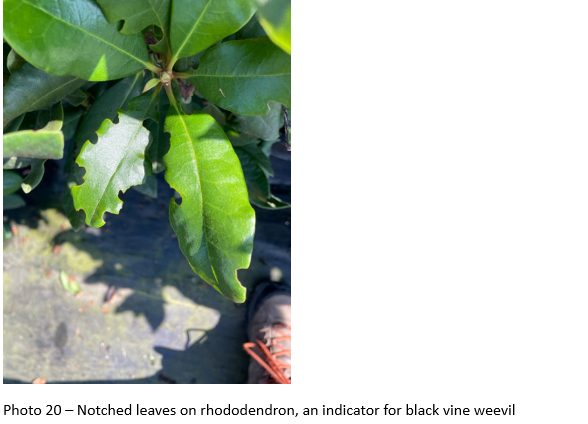
Snail and slug damage can often be overlooked as most of the damage occurs at night. In this case, I almost missed it due to the size!
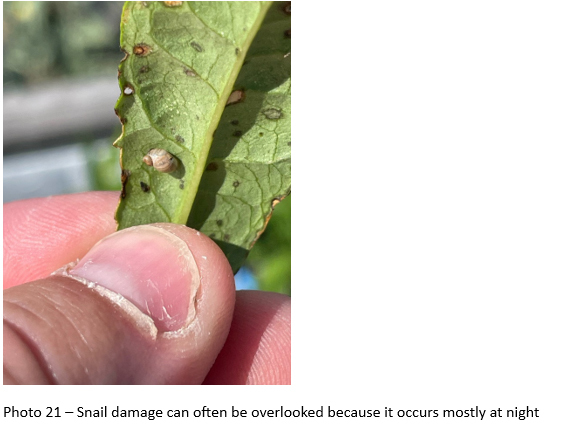
Finally, fire blight pops up occasionally. Here is a lab confirmed case on Asian pear ‘Tawara’.


INDIANA (July 16, 2024) — In a remarkable achievement for sustainable agriculture, the latest results from the Conservation Tillage Transect survey reveal that 1.7 million acres of farmland are now under living cover across all crops in Indiana. This significant milestone underscores the increasing adoption of cover crops by farmers, driven by their multiple benefits for soil health, water management and overall farm productivity.
“Protecting soil, our most vital natural resource, is top of mind for our Indiana farmers and year after year our farmers are breaking their own conservation records” said Lt. Gov. Suzanne Crouch, Indiana's Secretary of Agriculture and Rural Development. “Through the implementation of cover crops and other conservation efforts, farmers are ensuring our land and water resources remain healthy and productive for years to come."
Overwintering living covers (i.e. - cover crops and small grains, like wheat) are known for their environmental benefits. Cover crops and small grains help increase organic matter in the soil and improve overall soil health by adding living roots to the soil more months of the year. Cover crops also improve water infiltration into the soil, while other covers, like legumes serve as natural fertilizers.
Although the conservation transect does not differentiate between cover crops and small grains, Indiana farmers typically plant fewer than 300,000 acres of small grains annually, so cover crops vastly dominate the 1.7 million estimated acres. Apart from corn and soybeans, cover crops are planted on more acres than any other commodity crop in Indiana. Cover crops are typically planted in the fall after harvest and designed to protect the soil and keep roots in the ground throughout the winter, which improves soil health and helps filter water runoff.
"These results are very encouraging," said Damarys Mortenson, state conservationist for USDA’s Natural Resources Conservation Service in Indiana. "The adoption of cover crops on such a large scale indicates that farmers are recognizing the long-term benefits of these practices for both their land and the environment."
Farmers like Todd Armstrong, who operates a 1,100-acre farm in Washington County, have seen firsthand the advantages of cover crops.
“The water holding capacity and tilth of the ground has just improved so much and my neighbors have even seen that,” said Armstrong. “Neighbors that worked ground every year have stopped and started incorporating cover crops because they’ve seen how good it has worked for us.”
As a result of the cover crops and other overwintering covers planted last year, it is estimated that 1.8 million tons of sediment was prevented from entering Indiana’s waterways, which would fill about 18.4 thousand train freight cars.
The conservation survey also showed that about 69% of row crop acres were not tilled and about 17% had employed reduced tillage over winter, after the 2023 harvest. This early spring survey is not intended to quantify pre-planting tillage.
Despite the clear benefits, there are challenges to the widespread adoption of cover crops, including the initial cost of seeds and the need for additional management skills. However, various federal and state programs offer financial incentives and technical assistance to help farmers incorporate cover crops into their operations. One such initiative that helped contribute to the successful year for cover crops in 2023 was the Cover Crop Premium Discount Program (CCPDP). It is a program that provides a discount on crop insurance for planting cover crops. CCPDP assisted landowners in planting about 19 thousand acres of cover crops in 2023.
The conservation transect is a visual survey of cropland in the state. It was conducted between March and May 2024 by members of the Indiana Conservation Partnership, including the USDA Natural Resources Conservation Service, the Indiana State Department of Agriculture, Indiana’s Soil and Water Conservation Districts and Purdue Extension, as well as Earth Team volunteers, to show a more complete story of the state’s conservation efforts.
To see the full conservation transect report, click here.
![]()
ABOUT ISDA
The Indiana State Department of Agriculture (ISDA) reports to Lt. Governor Suzanne Crouch, Indiana’s Secretary of Agriculture and Rural Development. Major responsibilities include advocacy for Indiana agriculture at the local, state and federal level, managing soil conservation programs, promoting economic development and agricultural innovation, serving as a regulatory ombudsman for agricultural businesses, and licensing grain firms throughout the state.
ABOUT NRCS
NRCS is helping private landowners improve the health of their operations while protecting our natural resources for the future. With the mission of “Helping People Help the Land,” NRCS in Indiana provides financial and technical assistance to agricultural producers and non-industrial forest managers to implement conservation practices to address natural resource concerns on their land related to soil health, water and air quality, and wildlife habitat as well as implement climate-smart agriculture practices. USDA is an equal opportunity provider, employer and lender.

The Indiana State Department of Agriculture (ISDA) announced today the hiring of Clark Smith as director of the Indiana Grain Buyers and Warehouse Licensing Agency (IGBWLA).
A southern Indiana native, Smith was raised in Brownstown, IN. He and his wife now manage and oversee a family Angus cattle herd near Greenfield, IN. Smith attended Indiana University for his bachelor’s degree and graduated from the Kelly School of Business at Indiana University in 2019 with a Master of Business Administration focused on marketing and data analytics.
Previous to ISDA, Smith spent his professional career with Corteva Agriscience in crop protection management.
ISDA Director Don Lamb is excited to welcome Smith to the team.
“Farming is a financial business with a lot of risks. The goal of IGBWLA is to help mitigate some of those risks and ensure financial security and stability,” said Lamb. “We are looking forward to Clark’s expertise and knowledge in leading this very important division, for our department and our state.”
As director of the agency, Smith will be responsible for managing staff and overseeing the agency’s statutory obligations, which include approving new license applications and the auditing of Indiana’s commercial grain operations.
He will also serve as chairperson of the Indiana Grain Indemnity Corporation Board of Directorsand work with local, state and federal agencies, as well as the private sector, to better understand the needs of Indiana’s grain purchasers.
“Agriculture has been a huge part of my personal and professional life, and I am excited to begin the journey of public service and give back to this dynamic industry,” said Smith. “The Indiana Grain Buyers and Warehouse Licensing Agency has dedicated staff who keep the industry top of mind. I look forward to learning from them and working side by side with the ISDA team and stakeholders in all parts of Indiana, both Indianapolis and all the cities and towns that make Indiana great.”
Smith is a Greenfield Central school board member and Riley Festival board of directors member. He is also a 10 year 4H member from Jackson County and a former Jackson County Cattlemen’s President.
Outside of work, Clark and his wife Debra spend most of their time raising their two young daughters and managing the family Angus herd.
Visit www.isda.in.gov for more information about the Indiana Grain Buyers and Warehouse Licensing Agency.

The Indiana State Fair and Corteva Agriscience are proud to unveil the highly anticipated 2024 Featured Farmers that will be honored at this year’s Indiana State Fair.
In its ninth year, this popular program celebrates and helps put a face on Hoosier agriculture by connecting consumers with fellow Hoosiers who grow the food they eat. These 15 farm operations represent a variety of regions through the state, showcasing different agricultural products and stories throughout the 15-day state fair, August 2-August 18 (closed Mondays).
“Our mission at the Indiana State Fair is rooted in agriculture and connecting our fairgoers to the farmers feeding the world. We are proud of our Featured Farmer program and excited to unveil our 2024 honorees.” said Cindy Hoye, executive director, Indiana State Fair Commission. “These farmers have incredible stories to tell, and we are grateful to celebrate them with our partners at Corteva Agriscience.”
Visitors to the Indiana State Fair can attend a live chat at 2:30 p.m. in the Glass Barn with a Featured Farmer every day of the Fair, in addition to many other opportunities to talk with that day’s Featured Farm family and learn about their family operation. To learn more about the farmers, visit IndianaStateFair.com.
“The Indiana State Fair is the perfect place for fairgoers who are also consumers to meet Indiana farmers from across the state who dedicate their lives to feeding all of us. We are pleased to once again make this connection happen through the Featured Farmers program which is in its ninth year. At Corteva Agriscience, we are committed to enriching lives and helping farmers succeed,” said Heidi Spahn, Corporate and Community Investment Leader, Corteva Agriscience.
Here is the complete list of featured farmers, farm products and their home counties:
• Friday, August 2nd – Scarborough Farms (Soybeans), Laporte County
• Saturday, August 3rd – Paschen Farms Inc. (Pork), Cass County
• Sunday, August 4th – Howe Farms (Beef, Pork, Hops), Lake County
• Tuesday, August 6th – Lueken Dairy Farm (Dairy), Dubois County
• Wednesday, August 7th – Celtic Glen Heritage Livestock (Beef Cattle, Goats, Sheep, Rabbits), Owen County
• Thursday, August 8th – Union Go Dairy (Dairy), Randolph County
• Friday, August 9th – Blue Yonder Organic Farm (Organic Certified Farm Fresh Products), Hendricks County
• Saturday, August 10th – Kirk Hoffman & Family Farms (Corn, Soybeans, Wheat, Forage Production, Maple Syrup), Whitley County
• Sunday, August 11th – Fair Farms and Produce (Farm Fresh Produce), Hancock County
• Tuesday, August 13th – Advanced Ag Resources Inc. (Seed Corn, Seed Beans), Wabash County • Wednesday, August 14th – DDH Farms (Corn, Soybeans), Randolph County
• Thursday, August 15th – Winzerwald Winery (grapes, wine), Perry County
• Friday, August 16th – Tree City Bee Company (Honey Drink, Honey, Bees), Decatur County
• Saturday, August 17th – Everett Farms and Seed (Corn), Boone County
• Sunday, August 18th – 550 Wagyu (Beef), Tippecanoe County
The Great Indiana State Fair
The Indiana State Fair is the state’s largest multi-day event celebrating the Hoosier spirit and agricultural heritage. These 15 days bring all communities together to celebrate all things Indiana and promote it to hundreds of thousands of people across the state, and beyond. Nationally recognized for offering great entertainment, showcasing youth and interactive agriculture educational programs, premiere facilities and a variety of unique, fun foods, the Indiana State Fair has been an annual attraction for generations of Hoosiers since 1852. This year’s Indiana State Fair will take place August 2 – August 18 (closed Mondays). For information, visit www.indianastatefair.com.
About Corteva Agriscience
Corteva, Inc. (NYSE: CTVA) is a global pure-play agriculture company that combines industry-leading innovation, high-touch customer engagement and operational execution to profitably deliver solutions for the world’s most pressing agriculture challenges. Corteva generates advantaged market preference through its unique distribution strategy, together with its balanced and globally diverse mix of seed, crop protection, and digital products and services. With some of the most recognized brands in agriculture and a technology pipeline well positioned to drive growth, the company is committed to maximizing productivity for farmers, while working with stakeholders throughout the food system as it fulfills its promise to enrich the lives of those who produce and those who consume, ensuring progress for generations to come. More information can be found at www.corteva.com.
MidSouthern Bancorp, Inc. Third Quarter Operations
31 Oct 2024
Mid-Southern Bancorp, Inc. Announces its Quarterly Cash Dividend
31 Oct 2024
Business Newsletter From IN Secretary Of State
29 Oct 2024

18
Oct
Indiana Destination Development Corporation Announces Destination Development And Placemaking Grants
18 Oct 2024
Apply For Grants From Indiana Grown
17 Oct 2024
Compose Your Way To $10K In Indiana For Jingle Submissions
09 Oct 2024

07
Oct
ROI Awarded $9.5 Million DoD Contract To Advance Microelectronics Education, Workforce Training
07 Oct 2024
Premier Ag Constructing New Facility
02 Oct 2024

30
Sep
Graeter’s Ice Cream Raises More Than $2 Million to Help Find the Homerun Cure™ for Childhood Cancer
30 Sep 2024
NFIB Recognizes Nine Lawmakers: Guardians Of Small Business
23 Sep 2024
Temple & Temple Celebrates 76 Years Of Business By Giving Back To Southern Indiana
18 Sep 2024
Indiana's Small Businesses are Thriving in These Booming Industries
16 Sep 2024
Indiana’s Tax System: A Framework for Future Competitiveness
14 Sep 2024
BBB’s Annual Shred & Electronics Recycling Event To Be Held on Saturday, Sept. 28
12 Sep 2024

12
Sep
Indiana Chamber Foundation Releases Phase One of Tax Study, Providing Key Insights on Indiana's Tax Competitiveness
12 Sep 2024
American Water Works To Purchase Silver Creek Water Corporation
06 Sep 2024
Bad Apple: Walmart Recalls Apple Juice Due To High Arsenic Levels
23 Aug 2024
Washington County Business Recognized by Governor Holcomb
20 Aug 2024
BBB August Hot Topics
16 Aug 2024
Applications Open for 20th Annual Best Places to Work in Indiana Contest
14 Aug 2024
2024 Wellness Summit to Tackle Health and Well-Being, Leave Management and More
13 Aug 2024
Take The Southern Indiana Wage & Benefits Survey
09 Aug 2024
Manufacturing Readiness Grants Available
09 Aug 2024
Digital Decluttering Tips For Your Connected Life
07 Aug 2024
Meeting Addresses Creative Entrepreneurial Opportunities
25 Jul 2024
NLRB Overrules Metal Powder Products' Election Objections, Affirming Workers' Union Victory
16 Jul 2024
Washington County Local Products Guide
11 Jul 2024
River Ridge Development Authority Advances Strategic Land Sale
21 Jun 2024
31 Republicans Challenge Biden’s Overtime Rule that Will Crush Small Businesses
14 Jun 2024
SalemLeader.com
Leader Publishing Company of Salem, Inc.
P.O. Box 506
117-119 East Walnut Street
Salem, Indiana. 47167
Phone: 812-883-3281 | Fax: 812-883-4446
Business Hours:
Mondays through Fridays, 9:00am - 5:00pm
News:
news@salemleader.com
Office:
office@salemleader.com
Publisher:
publisher@salemleader.com
Business
- More Business News
- Go To Guide
- Business Directory
- Real Estate
- Auctions
Education
- More Education News
Opinion
- Editorials
- Letters to the Editor
- Columns
- Unsung Heroes
- Days Gone By
- In the Garden
- Guest Columns
- Reader's Poll
- Salem Leader Forum
- Questions and Answers
Church
- Bible Aerobics
- Church News
- Church Directory




















